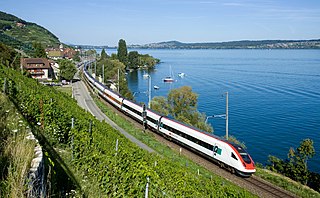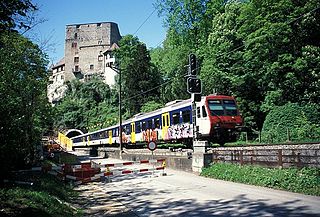
The canton of Bern, or Berne, is one of the 26 cantons forming the Swiss Confederation. Its capital city, Bern, is also the de facto capital of Switzerland. The bear is the heraldic symbol of the canton, displayed on a red-yellow background.

Biel/Bienne is a bilingual city in the canton of Bern in Switzerland. With over 55,000 residents, it is the country's tenth-largest city by population. The Biel urban area has a population of around 100,000 inhabitants. Biel/Bienne is the capital of the Biel/Bienne administrative district. The city has been an industrial and watchmaking heart of Switzerland since the 19th century. With world-famous watch brands such as Rolex, Omega and Swatch based in Biel/Bienne, the city is one of the main centres of the Swiss watch industry and is also referred to as the "world capital of watchmaking".

The A4 motorway in Switzerland begins from Schaffhausen, in northern Switzerland, and travels southward into central Switzerland.

Districts of Switzerland are a political subdivision for cantons. In the federally constituted Switzerland, each canton is completely free to decide its own internal organisation. Therefore, there exists a variety of structures and terminology for the subnational entities between canton and municipality, loosely termed districts. Most cantons are divided into Bezirke. They are also termed Ämter, Amtsbezirke, district or distretto. The Bezirke generally provide only administration and court organization. However, for historical reasons districts in cantons Graubünden and Schwyz are their own legal entities with jurisdiction over tax and often have their own Landsgemeinde.

The Bernese Oberland, sometimes also known as the Bernese Highlands, is the highest and southernmost part of the canton of Bern. It is one of the canton's five administrative regions. It constitutes the Alpine region of the canton and the northern side of the Bernese Alps, including many of its highest peaks, among which the Finsteraarhorn, the highest in both range and canton.
Switzerland has a two-class highway system: motorways with separated roads for oncoming traffic and a standard maximal speed limit of 120 kilometres per hour (75 mph), and expressways often with oncoming traffic and a standard maximal speed limit of 100 kilometres per hour (62 mph).

Urtenen-Schönbühl is a municipality in the Bern-Mittelland administrative district in the canton of Bern in Switzerland.

The Kander is a river in Switzerland. It is 44 kilometres (27 mi) long and has a watershed of 1,126 square kilometres (435 sq mi). Originally a tributary of the Aare, with a confluence downstream of the city of Thun, since 1714 it flows into Lake Thun upstream of the city.

BLS AG is a Swiss railway company created by the 2006 merger of BLS Lötschbergbahn and Regionalverkehr Mittelland AG. 55.8% of it is owned by the canton of Berne, and 21.7% by the Swiss Confederation. It has two main business fields: passenger traffic and infrastructure.

The A16, a motorway in north-central Switzerland, is a divided freeway connecting the border to France to the A5 motorway, 84 kilometres (52 mi) to the south on the Swiss plateau.

The Lötschberg line is a railway in Switzerland, connecting Spiez in the canton of Bern with Brig in the canton of Valais. It crosses the Bernese Alps, from the Bernese Oberland to Upper Valais, through the Lötschberg Tunnel in the middle of the line. Together with the Simplon Tunnel south of Brig, it constitutes one of the major railways through the Alps and an important north-south axis in Europe. The Lötschberg axis is backed by the lower and longer Lötschberg Base Tunnel, part of the New Railway Links through the Alps project.

The Swiss Central Railway was one of the five major private railway companies of Switzerland. The SCB with a track length of 332 kilometres was integrated into the Swiss Federal Railways (SBB) in 1902.

The Jura Foot Line or Jura South Foot Line, is a railway line in Switzerland. It runs from Olten along the foot of the southern Jura range through Solothurn, Grenchen, Biel/Bienne, Neuchâtel, Yverdon-les-Bains and Morges to Lausanne. It is one of two routes used by intercity trains between Geneva and Zürich. The other is the Midland line which connects Olten via Langenthal, Burgdorf, Bern, Fribourg, Lausanne to Morges. The line was built by five railway companies, which after several mergers were absorbed into the Swiss Federal Railways in 1903.

The A8 motorway, an Autobahn in central Switzerland, is a divided highway connecting the Bernese Oberland and the Innerschweiz. It is part of the National Road N8. For the Canton of Obwalden, it is the lifeline that has allowed the settling of industrial firms in this historically predominantly agricultural region. Via the A8, speedy connections to the major economic centers in the Mittelland and the north–south transit axis A2 are now possible. For tourists, A8 opens up in the opposite direction: the large ski resorts in the Bernese Oberland and the tourism regions around the Brünig Pass and Interlaken.

Biel/Bienne railway station serves the bilingual municipality of Biel/Bienne, in the canton of Bern, Switzerland.

The Biel/Bienne–Bern railway is a railway line in Switzerland and connects the city of Biel/Bienne with Bern. The line is owned by Swiss Federal Railways (SBB), long-distance services are operated by the SBB, and regional services are operated by the BLS.

The Basel–Biel/Bienne railway line is a standard gauge railway line of the Swiss Federal Railways (SBB) and the BLS AG. It runs from Basel SBB along the Birs in the French-speaking Jura to Delémont and Biel/Bienne. The traffic on the line is shown in table 230 of the official timetable.

The Biel/Bienne–La Chaux-de-Fonds railway is a single-track standard-gauge railway line of the Swiss Federal Railways (SBB).

Bern Wankdorf railway station is a railway station in the municipality of Bern, in the Swiss canton of Bern. It is the first station east of Bern and is an intermediate stop on multiple railway lines.

The InterCity are mainline trains in Switzerland connecting the country's major agglomerations, the range of services of which is located between InterRegio (IR) and EuroCity (EC). These trains are generally equipped with air-conditioned equipment, a CFF restaurant or a CFF bistro, a mini-bar service, a quiet area and a business area in 1st class as well as a family area or, occasionally, a family car in 2nd class.




















